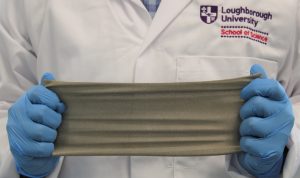Tech experts create groundbreaking energy-generating textiles that can produce electricity by capturing energy from body movements.
Clothing that can analyse our health, communicate information, and generate electricity may soon be available to the public due to new research conducted by researchers at Loughborough University. Dr Ishara Dharmasena, of the School of Mechanical, Electrical and Manufacturing Engineering (MEME), in collaboration with a team of researchers at the University of Moratuwa (Sri Lanka), has developed a new, scalable manufacturing technique to create energy-generating textiles embedded with very small power generators known as ‘Triboelectric Nanogenerators’ (TENGs).
The technique, which is detailed in a paper published in ACS Applied Electronic Materials, can turn common textile materials into energy-generating textiles utilising established methods such as yarn coating, dip coating, and screen-printing in which to apply triboelectrically active solutions.

Wearable TENG-containing fabrics
The wearable TENG-containing fabrics are similar in texture to knitted materials used to make jumpers and t-shirts. However, unlike your average pullover, these energy-generating textiles can produce electricity to operate low-power electronics using our natural body movements.
The 4cm-by-4cm lightweight and thin TENG textile that the researchers created produced over 35V of voltage using mild artificial movements that replicated slow body movements. This energy-generating textiles technology could potentially power health sensors, environmental sensors, and electronic devices in the near future.
How the energy-generating textiles technology works
“This technology will be massively beneficial for future smart textile and wearable electronic applications” explained Dr Dharmasena. “With this research, we were able to demonstrate that we can use the existing textile materials and common textile manufacturing techniques to produce wearable TENGs with balanced electrical and comfort properties.”
TENG devices collect static charges and once attached to the human body or clothing, the TENG devices ‘slide’ or ‘vibrate’ with bodily movements to create an electrical signal through a process called ‘electrostatic induction’.
Experts have looked to use TENGs in fabric before, but, as they were made of rigid and bulky plastic sheets and entailed expensive manufacturing techniques, past clothing applications have been unsuccessful.
Dr Dharmasena’s technique overcomes these issues by combing new conventional textile materials and carefully engineered TENG device designs.
This energy-generating textiles technology has displayed improved electricity generation and meets most of the comfort and durability requirements for textile products – a balance that has been very difficult to achieve so far in TENG research area.
This research is part of Dr Dharmasena’s Royal Academy of Engineering-funded project focused on creating sensor-containing super-smart textiles that can be used for remote health monitoring. He and his team are now looking at practical applications of TENG technology and intend to collaborate with industrial and academic associates in the areas of smart textiles, health sensing technologies, nanotechnology, and fabrication.









